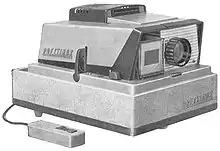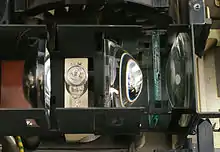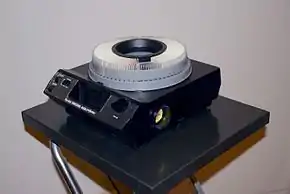Slide projector
A slide projector is an opto-mechanical device for showing photographic slides.


35 mm slide projectors, direct descendants of the larger-format magic lantern, first came into widespread use during the 1950s as a form of occasional home entertainment; family members and friends would gather to view slide shows. Reversal film was much in use, and supplied slides snapped during vacations and at family events. Slide projectors were also widely used in educational and other institutional settings.
Photographic film slides and projectors have mostly been replaced by image files on digital storage media shown on a projection screen by using a video projector or simply displayed on a large-screen video monitor.

History

A continuous-slide lantern was patented in 1881.[1] It included a dissolving views apparatus.[2]
Components
A projector has four main elements:
- electric incandescent light bulb or other light source (usually fan-cooled)
- reflector and "condensing" lens to direct the light to the slide
- slide holder
- focusing lens
A flat piece of heat-absorbing glass is often placed in the light path between the condensing lens and the slide, to avoid damaging the latter. This glass transmits visible wavelengths but absorbs infrared. Light passes through the transparent slide and lens, and the resulting image is enlarged and projected onto a perpendicular flat screen so the audience can view its reflection. Alternatively, the image may be projected onto a translucent "rear projection" screen, often used for continuous automatic display for close viewing. This form of projection also avoids the audience interrupting the light stream by casting their shadows on the projection or by bumping into the projector.
Types
- Straight-tray slide projectors
- Carousel slide projectors
- Stack-loader slide projectors
- Slide cube projectors
- Dual slide projectors
- Single slide projectors (manual form)
- Dissolve projectors
- Slide viewer projectors
- Stereo slide projectors project two slides simultaneously with different polarizations, making slides appear as three-dimensional to viewers wearing polarizing glasses
- Medium-format slide projectors
- Large-format slide projectors for use on stages, at large events, or for architectural and advertising installations where high light output is needed.
- Overhead projectors
Manufacturers
List of known manufacturers of slide projectors:
- Agfa Gevaert, Germany (–1984) → Reflecta (1984–)
- Bauer, Germany → Bosch; ceased production
- Bausch & Lomb; ceased production
- Bell & Howell / TDC, US: "Headliner"; ceased production
- Braun AG, Germany: "D", "PA"; ceased production
- Braun Foto Technik, Germany: "Paximat", "Multimag" → Reflecta
- VEB DEFA, Germany: "Filius"→ VEB Gerätewerk Friedrichshagen: "Filius"; ceased production
- Eastman Kodak (–2004): "Carousel-S", "Ektagraphic", "Ektapro" → Leica
- Elmo, Japan
- Enna, Germany; ceased production
- Erno Photo, Germany; ceased production
- VEB Feinmess, Germany; ceased production
- Filmoli, Germany → Gebr. Martin, Germany; ceased production
- Foto Quelle, Germany: "Revue"; ceased distribution
- GAF, US; ceased distribution
- Götschmann, Germany (1978–2009) → Gecko-Cam (2009–)
- Hasselblad, Sweden; ceased production
- HASPE, Germany; ceased production
- Hähnel, Germany; ceased production
- Inox, France: "Prestige" → Prestinox
- Kindermann, Germany: "Diafocus" → Leica
- Leitz, Germany (1958–): "Prado" → Leica Projektion GmbH Zett Gerätewerk, Germany (1990–2004): "Pradovit", "Pradovit RT" → Leica Camera, Germany (2004–2006): "Pradovit"; ceased production
- Liesegang, Germany: "Fantax", "Diafant", "Fantimat"; ceased production
- Malinski, Germany: "Prokyon", "Malicolor" → Pentacon
- Minolta, Japan; ceased production
- Minox, Germany: "Minomat"; ceased production
- Navitar, US
- Nikon, Japan; ceased production
- Ernst Plank, Germany: "Noris", "Trumpf"; ceased production
- Pentacon, Germany: "Aspectar", "Malicolor"; ceased production
- Asahi Pentax, Japan; ceased production
- Prestinox, France → Plawa Condor (1969–?); ceased production
- Pouva, Germany; ceased production
- RBT, Germany
- Queen, Germany: "Automat"; ceased distribution
- Reflecta, Germany: "Multimag"
- Rollei, Germany (1960–2007): "Rolleiscop", "Rolleivision" → Franke & Heidecke, Germany (2007–2009): "Rolleivision" → DHW Fototechnik, Germany (2009–2015): "Rolleivision"; ceased production
- Royal, Germany?; ceased distribution
- Sankyo, Japan; ceased production
- Sawyer's, US; company sold to GAF
- Silma, Italy → Bauer and Rollei; ceased production
- TAV Simda
- Vicom
- Vivitar, US
- Voigtländer, Germany: "Perkeo" → Zett
- Zeiss Ikon, Germany (1964/1969–): "Ikolux" → Zett
- Zeiss Jena, Germany → Pentacon, Germany
- Zett, Germany (1928–1989): "Fafix", "Zett", "Zettomat", "Perkeo" → Leica Projektion GmbH Zett Gerätewerk, Germany (1990–2004)
- CBИTЯ3ъ, Russia: "ABTO"; ceased production
References
General references
- Murphy, Burt (February 1973). Slide projectors get smarter all the time. Popular Mechanics. Retrieved 2011-10-22.
Inline citations
- The Canadian Patent Office Record and Mechanics' Magazine, Volume 9. 1881.
- Sloane, T. O'Conor. Facts Worth Knowing Selected Mainly from the Scientific American for Household, Workshop, and Farm Embracing Practical and Useful Information for Every Branch of Industry. Hartford: S. S. Scranton & Co. 1895.